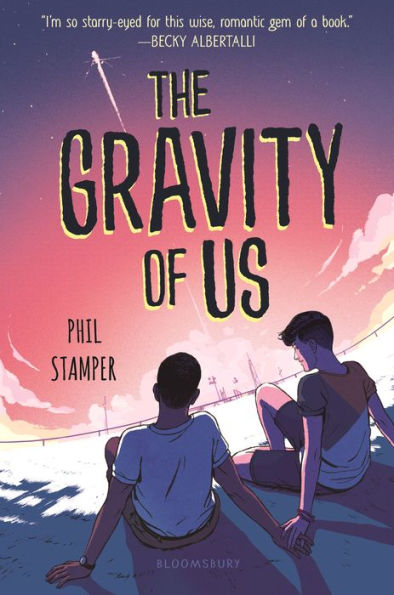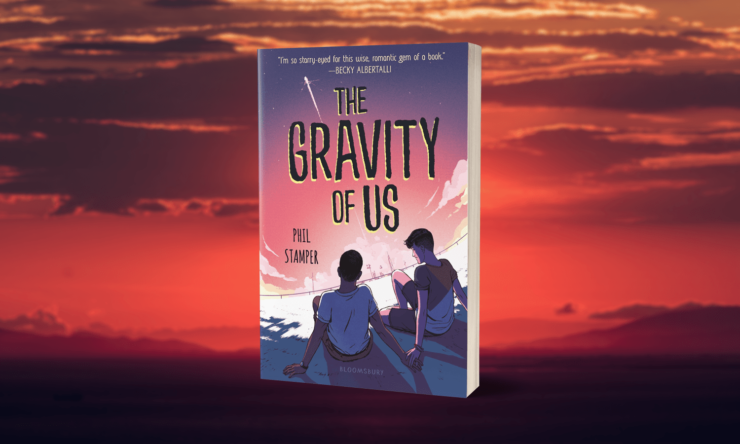The Gravity of Us by Phil Stamper is a queer young adult novel set in the near-future, centering equally on a blooming teenage romance and the national romance of space travel. NASA and reality television program StarWatch have paired up to garner public support for the first manned trip to Mars, intended to begin a survivable colony on the planet—and Cal Lewis Jr., an up-and-coming social media journalist who recently scored an internship at BuzzFeed, has been covering it as well… until his father is selected as the twentieth and final person on the Orpheus project team to go to Mars.
Cal must uproot his entire life, give up his chance at the internship, and step onto the national stage not just as a digital journalist but as a reality-TV participant. The Shooting Stars show is designed to replicate the perfect astronaut families of the ‘60s with added manufactured drama and an updated approach to diversity, but little focus on the actual science of the mission or its purpose. Cal refuses to give up his own media coverage, to the consternation of StarWatch, while he also begins a budding relationship with Leon, the son of another astronaut. But the real problem is the ethical question of what StarWatch is up to and where their loyalties lie: with the program, with the families, or with their own ratings?
The Gravity of Us is, at its core, a tender romantic story that revolves around coming-of-age and a passionate, nerdy love for space travel in America. Near-future speculative fiction is more rare that I’d expect in the young adult genre, perhaps because of the problem presented by the slow pace of publishing versus the fast pace of teen culture, technology, and current events. However, Stamper’s novel triangulates perfectly on a mix of familiar technologies and concerns projected ever so slightly ahead into a specific scenario—in this case, “what if we tried to secure funding and interest in a space program revival to go to Mars via reality television and streaming media?”
Buy the Book


The Gravity of Us
Cal’s significant social media presence, and how he approaches the idea of journalism, are represented in various lights: as a hobby by his parents, who don’t quite grasp that it’s literally his career; as a threat or a tool by the StarWatch team, who are willing to use him as needed for their own benefit; and as an asset by the NASA media folks, who are in a contentious relationship with StarWatch. Stamper introduces the reader to Cal initially as he explores his New York neighborhood via his streaming channel, while he’s simultaneously working through his own feelings about being a persona or public figure—and then later, we begin to see how different that experience is when he’s not in control of the narrative.
Light spoilers.
However, with this as well as a handful of other arguments the book approaches and then doesn’t pursue vigorously, Stamper stopped shy of where the problems of social media teens, broadcasting a whole life, and “persona” management get crunchy and interesting. Because The Gravity of Us is concerned with presenting an ultimately light-hearted, optimistic, and pleasant narrative, the potential for conflict is sometimes elided to give comfort in place of deeper complexity. On a similar note, the subplot of his fraught relationship with his best friend Deb is resolved a bit too neatly. Though Cal acknowledges he was a bad friend to her for a significant portion of the book, the fact the he more or less ignores her through the biggest upheaval of her life and then is forgiven so easily for that in the end rings a bit hollow.
Taken as a whole, The Gravity of Us is a sweet afternoon read, one that treads lightly on a variety of significant topics for younger audiences. From the developing arena of social media journalism, to debates about funding for space exploration (as a type of colonial project) when American infrastructure is crumbling, to the presence of private contractor companies (such as a narrowly fictionalized version of Space-X) working alongside and against NASA, and so on—Stamper has woven in a great deal of background, real-world problems with his speculation about how a mission to Mars would go, both as a practical concern and an ideological symbol. While he comes down on the side of ‘important ideological symbol,’ he also doesn’t utterly avoid the criticisms of where money gets spent and on what, governmentally.
On a more personal level, the book is also making a few good arguments about ethical behavior. Mental health and being present in relationships, specifically focusing on one’s own self instead of trying to fix others, is a big part of the romance between Leon and Cal. The combination of an anxious people-pleaser and a person with depression who can’t figure out what path he wants to take in life is a messy one, and perhaps the strongest take-away of the book is to be found in their efforts to meet each other in the middle and co-create a healthy relationship, despite their respective challenges. While there’s certain unbelievable neatness to that, for me, that is the whole point of the happily-ever-after structure… and queer teens, too, deserve to have happy romances where people do actually come together and care for each other.
Ultimately, I’m reminded of similar texts like Love, Simon and the novel that film was based on—not in terms of the plot, but in terms of the willful positivity, the sense that a pair of queer teenage boys can make something beautiful together while also having tiffs and struggles as any kids would. (Bonus, he doesn’t ignore that homophobia exists and inflects their lives as well, he just doesn’t make it the point of the narrative.) Stamper weaves a romantic coming-of-age in successfully alongside a plot that’s equal parts evolving drama around a mission to Mars and commentary on the nature of journalism, social media, and governmental interactions with the sciences. Overall, it’s touching on a lot of things lightly—and though it doesn’t dig particularly deep at any point, I understand the need to have pleasant reads like this. The Gravity of Us didn’t leave a strong or lingering impression on me, but it felt nice to read, and that counts for something too.
The Gravity of Us is available from Bloomsbury.
Lee Mandelo is a writer, critic, and editor whose primary fields of interest are speculative fiction and queer literature, especially when the two coincide. They have two books out, Beyond Binary: Genderqueer and Sexually Fluid Speculative Fiction and We Wuz Pushed: On Joanna Russ and Radical Truth-telling, and in the past have edited for publications like Strange Horizons Magazine. Other work has been featured in magazines such as Stone Telling, Clarkesworld, Apex, and Ideomancer.










